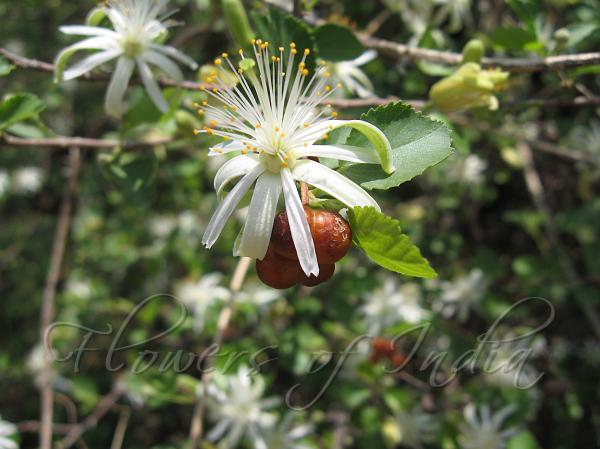|
| White Crossberry |
|

|

| File size | 1092658 |
| Original date | 6/21/07 1:13 PM |
| Resolution | 2592 x 1944 |
| Flash | Flash did not fire, auto, red-eye reduction |
| Focal length | 5.8mm |
| Exposure time | 1/400s |
| Aperture | 5.6 |
| Focus Distance | |
| Metering Mode | Multi-segment |
| Camera make | Canon |
| Camera model | Canon PowerShot A530 |
| Sensor type | OneChipColorArea |
|
|
|
Photo: |
Botanical name: Grewia tenax Family: Tiliaceae (Falsa family)
White Crossberry is a multistemmed shrub up to 2 m tall. It is a very close
cousin of the Falsa फ़ाल्सा popularly eaten as a fruit in India. Bark smooth,
grey, very fibrous so that twigs are hard to break. Leaves alternate,
almost circular in outline, 1.5-4 cm in diameter, margins toothed and
prominently tri-nerved at the base, often hairy, particularly beneath with
star shaped hairs. Stipules inconspicuous, falling early. Flowers solitary
or in pairs, axillarily placed, petals white, about 1 cm long; sepals long
and recurved. Fruit orange-red at maturity, with 1-4 spheroid lobes. The
genus was named after Nehemiah Grew (1641-1712), one of the founders of
plant physiology. White Crossberry is highly drought resistant and occurs
in the driest savannas at desert margins. In Delhi, it is found growing
wild in the rocky areas, like the JNU campus. The fruits consumed by man
and animals contain a large amount of iron and can be made into a
refreshing drink. Fruit storage can be extended by drying. The dead leaves
are eaten, but only while they remain on the plant. Young leaves are
consumed by livestock, they are slightly palatable at the end of dry
seasons, and have fairly good feed value.
| Identification credit: Tabish | Photographed in Garden of Five Senses, Delhi. |
• Is this flower misidentified? If yes,